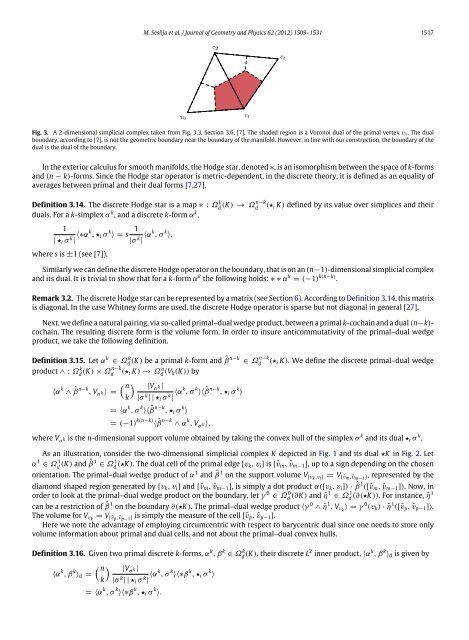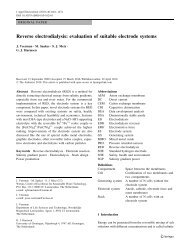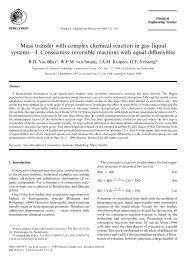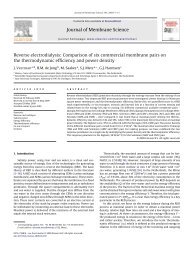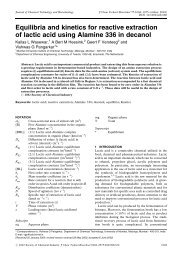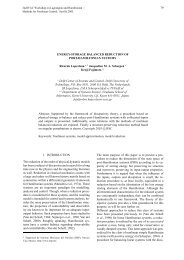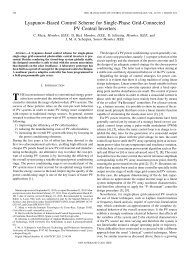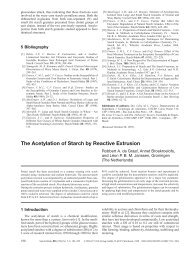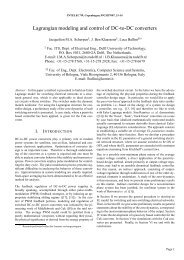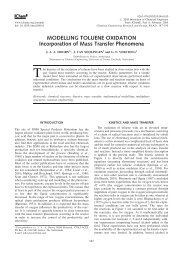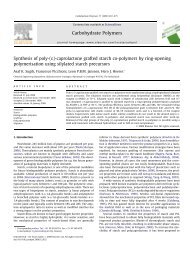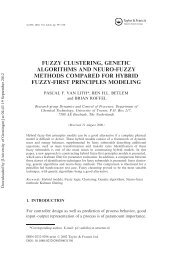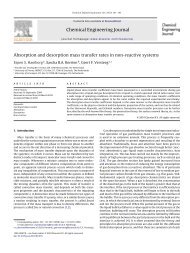Discrete exterior geometry approach to structure-preserving ... - ITM
Discrete exterior geometry approach to structure-preserving ... - ITM
Discrete exterior geometry approach to structure-preserving ... - ITM
Create successful ePaper yourself
Turn your PDF publications into a flip-book with our unique Google optimized e-Paper software.
M. Seslija et al. / Journal of Geometry and Physics 62 (2012) 1509–1531 1517Fig. 3. A 2-dimensional simplicial complex taken from Fig. 3.3, Section 3.6, [7]. The shaded region is a Voronoi dual of the primal vertex v 1 . The dualboundary, according <strong>to</strong> [7], is not the geometric boundary near the boundary of the manifold. However, in line with our construction, the boundary of thedual is the dual of the boundary.In the <strong>exterior</strong> calculus for smooth manifolds, the Hodge star, denoted ∗, is an isomorphism between the space of k-formsand (n − k)-forms. Since the Hodge star opera<strong>to</strong>r is metric-dependent, in the discrete theory, it is defined as an equality ofaverages between primal and their dual forms [7,27].Definition 3.14. The discrete Hodge star is a map ∗ : Ω k n−kd(K) → Ωd(⋆ i K) defined by its value over simplices and theirduals. For a k-simplex σ k , and a discrete k-form α k ,1| ⋆ i σ k | ⟨∗αk , ⋆ i σ k ⟩ = s 1|σ k | ⟨αk , σ k ⟩,where s is ±1 (see [7]).Similarly we can define the discrete Hodge opera<strong>to</strong>r on the boundary, that is on an (n−1)-dimensional simplicial complexand its dual. It is trivial <strong>to</strong> show that for a k-form α k the following holds: ∗ ∗ α k = (−1) k(n−k) .Remark 3.2. The discrete Hodge star can be represented by a matrix (see Section 6). According <strong>to</strong> Definition 3.14, this matrixis diagonal. In the case Whitney forms are used, the discrete Hodge opera<strong>to</strong>r is sparse but not diagonal in general [27].Next, we define a natural pairing, via so-called primal–dual wedge product, between a primal k-cochain and a dual (n−k)-cochain. The resulting discrete form is the volume form. In order <strong>to</strong> insure anticommutativity of the primal–dual wedgeproduct, we take the following definition.Definition 3.15. Let α k ∈ Ω k(K) d be a primal k-form and ˆβ n−k ∈ Ω n−kd(⋆ i K). We define the discrete primal–dual wedgeproduct ∧ : Ω k n−kd(K) × Ωd(⋆ i K) → Ω n d (V k(K)) by n⟨α k ∧ ˆβ n−k |V, V σ k⟩ =σ k|k |σ k | | ⋆ i σ k | ⟨αk , σ k ⟩⟨ ˆβ n−k , ⋆ i σ k ⟩= ⟨α k , σ k ⟩⟨ ˆβ n−k , ⋆ i σ k ⟩= (−1) k(n−k) ⟨ ˆβ n−k ∧ α k , V σ k⟩,where V σ k is the n-dimensional support volume obtained by taking the convex hull of the simplex σ k and its dual ⋆ i σ k .As an illustration, consider the two-dimensional simplicial complex K depicted in Fig. 1 and its dual ⋆K in Fig. 2. Letα 1 ∈ Ω 1 d (K) and ˆβ 1 ∈ Ω 1 d (⋆K). The dual cell of the primal edge [v k, v i ] is [ˆv m , ˆv m−1 ], up <strong>to</strong> a sign depending on the chosenorientation. The primal–dual wedge product of α 1 and ˆβ 1 on the support volume V [vk ,v i ] = V [ˆvm ,ˆv m−1 ], represented by thediamond shaped region generated by [v k , v i ] and [ˆv m , ˆv m−1 ], is simply a dot product α([v k , v i ]) · ˆβ 1 ([ˆv m , ˆv m−1 ]). Now, inorder <strong>to</strong> look at the primal–dual wedge product on the boundary, let γ 0 ∈ Ω 0(∂K) d and ˆη1 ∈ Ω 1 d(∂(⋆K)). For instance, ˆη1can be a restriction of ˆβ 1 on the boundary ∂(⋆K). The primal–dual wedge product ⟨γ 0 ∧ ˆη 1 , V vk ⟩ = γ 0 (v k ) · ˆη 1 ([ˆv p , ˆv p−1 ]).The volume for V vk = V [ˆvp ,ˆv p−1 ] is simply the measure of the cell [ˆv p , ˆv p−1 ].Here we note the advantage of employing circumcentric with respect <strong>to</strong> barycentric dual since one needs <strong>to</strong> s<strong>to</strong>re onlyvolume information about primal and dual cells, and not about the primal–dual convex hulls.Definition 3.16. Given two primal discrete k-forms, α k , β k ∈ Ω k d (K), their discrete L2 inner product, ⟨α k , β k ⟩ d is given by n⟨α k , β k |V⟩ d =σ k|k |σ k | | ⋆ i σ k | ⟨αk , σ k ⟩⟨∗β k , ⋆ i σ k ⟩= ⟨α k , σ k ⟩⟨∗β k , ⋆ i σ k ⟩.


